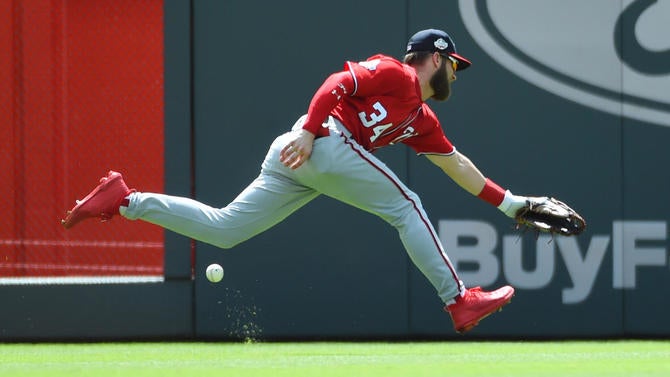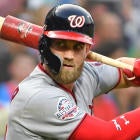Free-agent outfielder Bryce Harper remains on the open market. He's a former MVP who's still just 26 years of age, which in large measure explains why he's probably going to sign the biggest contract in MLB history. Whoever winds up inking him -- the Phillies, incumbent Nationals, and White Sox seem like the most serious contenders at the moment -- will no doubt be hoping he improves upon what was, by Harper's standards, a disappointing 2018.
So what was behind his difficulties this past season and will he indeed move forward from them? Let's explore four possible explanations or outcomes.
1. His struggles were relative to his peak seasons
Yes, Harper last season batted just .249, but thanks to his excellent secondary skills -- i.e., his ability to hit for power and his willingness to take walks -- he wound up with an OPS of .889. That's the third-highest mark of his career. Framed another way, his OPS+, which is OPS adjusted to reflect home ballpark and league conditions, was 33 percent better than the league average. Harper struggled relative only to his peak seasons to date and, on another level, only if you fixate too much on his batting average.
2. His former hitting coach has a theory
Fair enough, but what happened to cause Harper to fall short of his 2017 standards, let alone his MVP standards of 2015? Here's one opinion from someone in a position to know:
Kevin Long, Nats hitting coach told us “I thought Bryce got caught up in the launch angle stuff early in the season” but returned to the “boring line drives” approach and saw his season return to form @MLBNetworkRadio
— Jim Duquette (@Jim_Duquette) January 15, 2019
Many hitters these days focus on elevating the ball with the proper attack angle and an emphasis on making contact a little below the "equator" of the baseball. Some like J.D. Martinez, Josh Donaldson and Justin Turner have leveled up in a big way thanks to the launch angle revolution. The approach, however, is not a panacea for what ails every hitter. It's possible Harper was a poor fit for such tweaks, which is what Kevin Long implies above.
While Harper did show a somewhat depressed line drive rate in April, it was neither huge nor his lowest monthly mark of the 2018 season. Overall, though, Harper authored a batting average on balls in play (BABIP) of .289 versus a pre-2018 career mark of .323. There's some inherent randomness in BABIP, even on the hitter's side, but maybe an unsuitable approach sunk his numbers early in the season. His monthly BABIPs from 2018 suggest that's a possibility.
| 2018 month | Harper's BABIP |
|---|---|
April | .219 |
May | .194 |
June | .275 |
July | .333 |
August | .394 |
September | .328 |
Those kinds of results certainly fit with the story Long is telling, so perhaps there's something to it. Also early in the year, Harper struggled against increased infield overshifts. As the year went on, though, his percentage of hits to the opposite field increased, and in perhaps related matters his numbers lifted.
It's also worth noting that Harper's overall 2018 numbers were dragged down by an inordinately bad June. Peep the digits:
| 2018 month | Harper's OPS |
|---|---|
April | .986 |
May | .851 |
June | .675 |
July | .857 |
August | .959 |
September | .958 |
As you see, Harper was at vintage level or something close to it in every month except for June. In particular, he slugged just .341 for that that month. Mostly that was because he homered on just 10.5 percent of fly balls, which is roughly half of his career rate. That's almost certainly a random fluctuation (or perhaps something linked to an unreported injury).
In the end, it's easy to explain away Harper's relative drop in production from last season in ways that don't necessarily raise concerns going forward.
3. He's a volatile player
If Harper were a stock, we'd say he has a high beta. That's because his overall value has fluctuated pretty drastically from year to year. For instance, here are his seasonal OPS+ totals across his seven big-league seasons: 118, 133, 111, 198, 114, 156, 133. First, note that Harper has never been a bad hitter -- he's always produced better than the league average, even at his worst. But he swings wildly around that overall career OPS+ of 139. His worst OPS+ preceded his best, which preceded his second-worst, for instance.
Along those same lines, here are his year-to-year WAR totals: 5.2, 3.7, 1.1, 10.0, 1.5, 4.7, 1.3. He's gone from below-replacement level at times to downright Ruthian/Maysian/Bondsian (that 10.0 WAR in his MVP season of 2015). In part that's because his defensive performance has also fluctuated greatly from season to season. Speaking of which ...
4. His fielding dragged down his overall value
By pretty much any measure, Harper's numbers with the glove were worse than ever in 2018, and that raises concerns moving forward. Is he declining early? Is he bound for first base or DH sooner than anyone might think? Those are valid concerns, especially given that the advanced metrics are in general agreement that Harper was a terrible defender last season. Ben Lindbergh of The Ringer not long ago did a deep dive into this subject, and he found some evidence that Harper was scaling back his defensive effort in the name of self-preservation.

Whoever signs Harper probably needs to convince themselves that such a "business decision" indeed underpinned Harper's decline with the glove. Otherwise, the risk of deep collapse during what's probably at least a 10-year deal will be quite high. In matters related, Harper has dealt with knee problems throughout his big-league career. In order to stay healthy, he made to focus his instances of maximum effort and cut down on any "eyewash" hustle that could lead to more wear and tear on his knees. As well, getting him out of center field (he played almost 500 innings there in 2018) will likely help the numbers, since he's no longer passable at that position. What the market bears for Harper will say a great deal about how teams project his defensive value moving forward.
Here's what the projections say
The SportsLine Projection Model (@SportsLine on Twitter) forecasts Harper in 2019 to bat .270/.381/.530 with 29 home runs in 130 games. This past season, he slashed .249/.393/.496 with 34 home runs in 159 games. That's a pickup of 22 points of OPS. Given that OBP is the most important component of OPS and Harper gives back a little, it's basically a wash on a rate basis. As noted, though, history suggests Harper can hit the upper or lower bound his projections more frequently than most, so the error bars are pretty wide with him. Also as noted, much of his overall value will be determined by whether he can put up more adequate numbers with the glove.
It's always the case that teams must hazard a best guess at what a player is going to be in the future when they decide to offer him a free agent contract. The past matters only to the extent that it informs those forward-looking assumptions. In Harper's case, the answer is less clear and the stakes perhaps higher than ever.


















